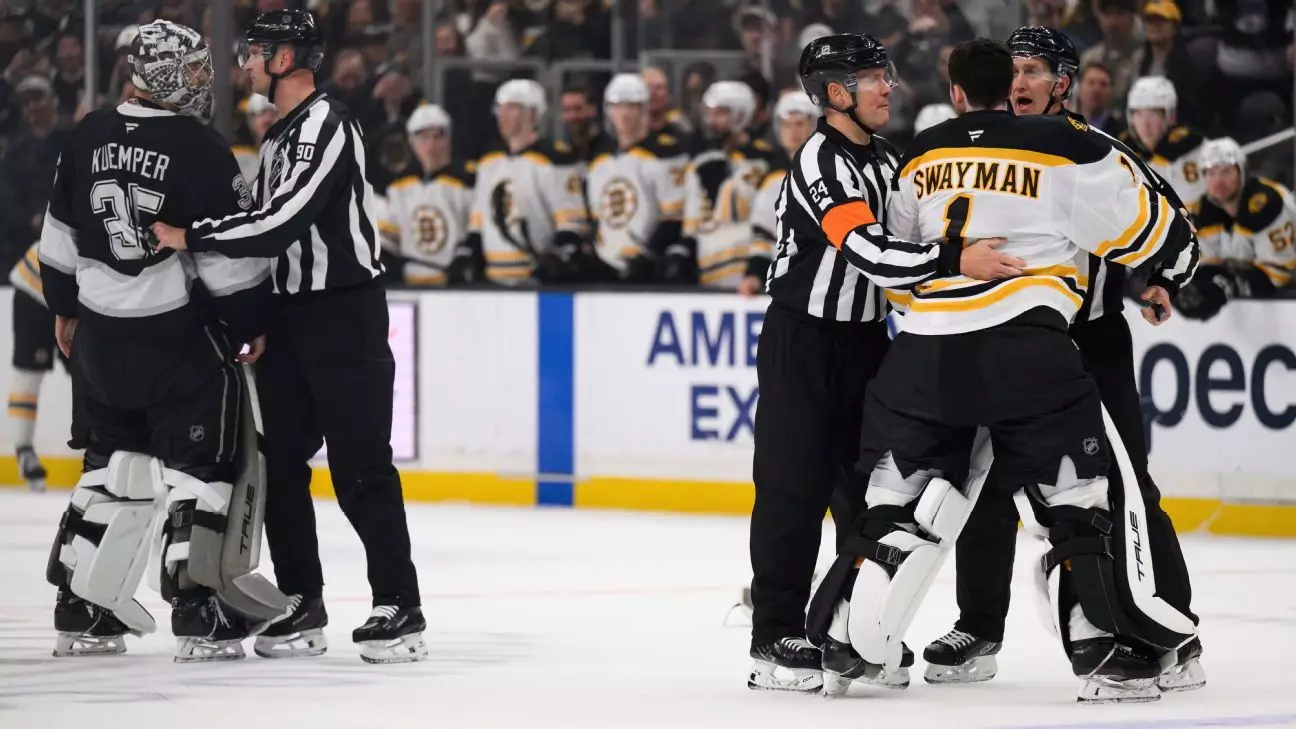In a recent match between the Los Angeles Kings and Boston Bruins, tensions flared significantly when goalies Darcy Kuemper and Jeremy Swayman almost exchanged blows in what many hockey fans would consider a spectacle. While the excitement of a goalie fight can send chills down the spine of die-hard fans, it’s perhaps best that officials intervened. As Kings coach Jim Hiller pointed out, the stakes in professional hockey are extraordinarily high, and the last thing any coach—let alone an entire organization—wants is to see their star players engaged in a physical altercation that could lead to injury.
The heart of the conflict stemmed from a controversial play whereby Bruins forward Marat Khusnutdinov collided with Kuemper after being checked into the boards by Tanner Jeannot. The ensuing penalty for goaltender interference led to a heated exchange, prompting Kuemper to assert his dominance and physically confront Khusnutdinov. However, what most people may overlook amid the passion of the moment is the severe risk involved in such confrontations, not just for the players’ health, but for the integrity of the game itself.
Why Such Altercations Are Risky
In the case of Kuemper and Swayman, the potential backlash from a fight could have far-reaching consequences. Injuries to pivotal players not only impact individual careers but also distort entire team dynamics. Hiller’s excitement upon realizing that his goalie was saved from a fight is evidence of the pragmatic mindset required in sports management—one that often prioritizes strategy over spectacle. It’s one thing for fans to relish the thought of a showdown, but for coaches, such scenarios provoke anxiety. Given that Kuemper has been on an impressive performance streak, the notion of risking his health for a moment of fanfare is imprudent.
The risk of injury is compounded by the fact that both Kuemper and Swayman are vital to their teams’ playoff aspirations. Both goalies have enjoyed remarkable seasons, making their availability crucial for any postseason success. Hiller’s reluctance to see his lead goalie engage in fisticuffs highlights the growing acknowledgment that while physicality is a cornerstone of hockey, preserving talent is more important than indulging in theatrics.
The Changing Landscape of Goalie Fights in the NHL
The last significant goalie fight in the NHL occurred back in 2020, an incident that some have argued should remain isolated in history. Since then, there has been a notable decline in such confrontations, signaling a shift in how the game is perceived and played. Noteworthy attempts by goalies like Swayman to provoke a fight have often been met with ridicule or outright refusal from opponents. This can partly be attributed to an evolving culture within the sport, where camaraderie sometimes trumps the desire for brute force.
The question arises whether this should lead to a more nuanced discussion about the role of fights in hockey, particularly goalie fights that can derail a game’s flow and ecosystem. Shouldn’t the focus be on skill, strategy, and teamwork rather than risking a player’s wellbeing over a moment fueled by adrenaline? Other sports may not experience this intersection of roles as prominently, leading one to wonder if the NHL should examine the implications of allowing such fights to occur.
The Fan Experience: Does Violence Really Add to the Drama?
While the spectacle of a fight may invigorate fans in the stands or watching at home, the reality is that such violence may detract from the beauty of the game itself. Hockey is a sport that thrives on strategy, skill, and teamwork. The desire to see goalies clash may stem more from a cultural love for aggression than from an appreciation of what makes hockey unique.
As the Kings celebrated their substantial win against the Bruins, it’s clear there is so much more to love about the game than the sheer thrill of physical confrontations. Enthusiasts argue that high-level plays, strategic maneuvers, and the suspense of tight games deliver all the drama needed to keep audiences on the edge of their seats. That allure should be enough without adding the chaotic element of potential fights, especially involving goalies.
People often crave that spark that draws them to live hockey matches, but there are many ways to achieve this without jeopardizing players’ futures. The incident involving Kuemper and Swayman serves as a reminder that the most riveting parts of hockey come not from raw aggression, but rather the finesse and skill that each player employs during the game. As the sport evolves, fans may need to rethink what constitutes true entertainment in hockey—perhaps it’s not the fights that should reignite passions, but the art of the sport itself.

